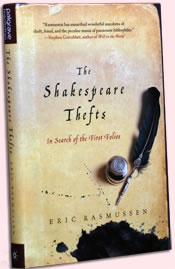A Novel Detective Keeps Close Watch
Over Shakespeare's Greatest Legacy
 The Shakespeare Thefts: In Search of the First Folios
The Shakespeare Thefts: In Search of the First Folios
Eric Rasmussen (Palgrave Macmillan, 2011)
Even William Shakespeare might never have created a character like Raymond Rickett Scott. He never had a job, never went to college, and at 53 he lived in a small house with his 82-year-old disabled mother in a working class neighborhood of Durham, England. Yet, Scott presented himself as a flamboyant millionaire, flaunting jewelry, clothes, and cars. He arrived at a court hearing in a silver stretch limo, dressed in white, holding a cigar in one hand and a cup of instant noodles in the other, and reading from Shakespeare's Richard III. His own defense attorney offered a scathing character reference in trying to convince a jury that Scott was either delusional or simply a fool.
Scott was on trial for the theft of Shakespeare's First Folio from the Durham University Library (Scott's money came from his parents' savings and racking up credit card charges, but he may also have trafficked in rare books). He is one of many fascinating characters peopling Eric Rasmussen's book, The Shakespeare Thefts: In Search of the First Folios. The book's cast ranges from a Spanish ambassador in King James I's court through a 19th century forger to a Japanese businessman who ordered in his will that no one could even look at his copy of the First Folio until 13 years after his death. But the main character in Rasmussen's quick-reading book—212 pages including notes—is the First Folio itself as it survives many singular adventures since its publication in 1623.
Over the past decade, Rasmussen has led a team of scholars to examine and extensively catalog every one of the 232 known copies of Shakespeare's First Folio in the world. Published in 2011, The Shakespeare First Folios: A Descriptive Catalogue is a detailed page-by-page descriptor of stains and marks, tears and fixes, covers and bindings, missing and fraudulent pages, and, most intriguingly, “marginalia,” the notes people wrote on the pages. It's a great tool for scholars and for detectives, too, but not necessarily an exciting read for the layperson.
So, Rasmussen gives us The Shakespeare Thefts, a Reader's Digest version of the people, past and present, he and his team encountered as they sought out every existing copy of the book Shakespeare's fellows in The King's Men, John Heminges and Henry Condell, put together. At 908 pages and bound in calfskin, the First Folio was an unprecedented presentation of theatrical works; it cost £1, one-fourth the annual salary of a skilled tradesman at the time. Today, they sell for as much as $7 million. Original owners included three earls, two bishops, an admiral, an ambassador, a knight, and a lawyer; subsequent owners included kings, the descendants of Harry Hotspur, the ancestors of Princess Diana, and railroad, oil, and hotel magnates.
Some owners left behind scribbling in the margins: personal revelations, gossip, and even mathematical formulas. The University of Oxford's copy shows the wear and tear from students leafing through the First Folio within the 50 years of its publication, evidence that suggests Romeo and Juliet was the most popular play in the volume. Another First Folio has a bullet hole traversing the first half, stopping at Titus Andronicus. “Punsters might suggest that Titus is an impenetrable play,” Rasmussen writes.
With this kind of light-handed touch, überscholar Rasmussen portrays some of the characters who trafficked in First Folios. Even Pope Paul VI filched a copy (kind of: he thought it was a gift). The most recent First Folio trafficker to make the headlines is the above-mentioned Raymond Rickett Scott. He showed up at the Folger Shakespeare Library in Washington, D.C., in 2008 with a First Folio in hand and a tale of a Cuban mistress and antiques dealer wanting to assess its authenticity. Thanks to the careful cataloging accomplished by Rasmussen's team, experts were able to identify Scott's copy as that stolen from Durham University in 1998, leading to his arrest, trial, and conviction (Scott died of apparent suicide in his jail cell this past spring). Rasmussen also writes of the distinctive trail left from the early 19th century by one John Harris, who probably handled more First Folios than perhaps anybody since the original printers. Because of his expertise in forgery, he was hired by many First Folio owners to “fix” damaged pages, and he was so good at it that the British Museum finally ordered him to sign any pages he re-created.
In addition to providing these and other true crime stories, Rasmussen delves into the legend that Shakespeare's famous volume may also have been cursed, since many First Folio owners met untimely deaths. One went down on the Titanic, another was killed by a windmill.
But the greatest mysteries in The Shakespeare Thefts are the First Folios that got away. Rasmussen discusses the importance of a First Folio's provenance, its string of ownership over the centuries. Take, for instance, the University of Oxford's copy. It disappeared some time between 1635 and 1674. In 1905, an undergraduate donated a First Folio that he had found in his family's library; it turned out to be the very same one that had been stolen from the university.
The trail backward is important for scholarship; the trail forward, though, is perhaps more important, as known copies are currently not accounted for. Some First Folios met their own untimely demises: one went down in an 1854 shipwreck, another was lost in the Great Fire of Chicago in 1871. Others simply have disappeared, though they may be in a private collection or the horde of a thief still looking for a buyer; last mentions of some First Folios, in fact, are associated with shady characters.
In reading Rasmussen's book, you might find yourself enraptured by the whereabouts of two First Folios in particular. One was purchased by the colorful Count Gondomar, the ambassador of Spain to England. He took his copy back home at the time of the Spanish Inquisition, and apparently the inquisitors censored some of its passages. The last known whereabouts of this copy was near an incinerator in the early 1840s as an estate worker was destroying old volumes from the Gondomar library, a report that came from a man who, evidence suggests, might have pilfered the volume himself. More intriguing is the First Folio owned by William Beeston, the son of Christopher Beeston who had been an apprentice to the Lord Chamberlain's Men, Shakespeare's company before it was renamed the King's Men. How the younger Beeston came to own a First Folio is unknown, but if he inherited it from his father, an actor in Shakespeare's time, imagine the marginalia it might contain?
Reading The Shakespeare Thefts, you'll end up hoping either or both of these last referenced copies show up by the end of the book. That's what makes this tiny tome a page-turner. It's also, in a subtle way, how Rasmussen presses his overall theme, for the reader can't help sharing Rasmussen's frustration that so many First Folios are lost or, worse, locked away. Throughout The Shakespeare Thefts, Rasmussen comes back several times to that reclusive Japanese businessman and the fact that even 13 years after his death, the family still refuses to allow anybody access to his First Folio. Might his copy be the Beeston or Gondomar copy? Based on the timing of First Folios in the late 1970s being snapped up in Japanese auctions, it might be any one of some other notable versions currently off the grid. We'll never know until the current owner allows it to be studied. Likewise, we're handcuffed by other nonidentified owners who keep their treasure buried in their private vaults.
Certainly, owners of such a rare and valuable book have the right to remain anonymous; revelation is an invitation to thieves. Furthermore, while the cataloging that Rasmussen and his team did is a vital tool in tracking First Folios through the black market, it also gives traffickers access to the special marks and attributes they would need to alter to disguise that particular copy. It's a Catch-22 for First Folio lovers. For the rest of us, it's a piece of unshared Shakespeare.
Eric Minton
November 4, 2012
Comment: e-mail [email protected]
Start a discussion in the Bardroom



 Find additional Shakespeareances
Find additional Shakespeareances